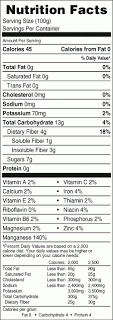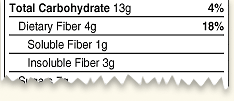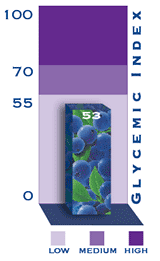Just the Facts (More or Less) – A Nutrition Label Analysis

Do the Super Chocolate Sugar-Os you had for breakfast claim to combat heart disease? Did that 20-ounce bottle of soda from the vending machine you polished off during lunch say it actually contains 2.5 servings?
If so, you are a casualty of Nutrition Labeling.
Nutritional Labels began showing up on food packaging in 1992 as a result of an effort from the Food and Drug Administration and the USDA to help consumers better understand the food they are eating. Since then, the ubiquitous black and white rectangle has endured criticism and ridicule as a tool to improve eating habits. For starters, they often present unrealistic serving sizes, and their polysyllabic ingredient lists can require a Ph.D. in Nutrition (or Philology) to translate.
 These little boxes also epitomize the challenge of too much and too little. By leaving out the stuff we could use – such as daily values for trans-fats, for example, which can lead to the development of heart disease – they sometimes come up short by offering information without a way for the consumer to actually use it.
These little boxes also epitomize the challenge of too much and too little. By leaving out the stuff we could use – such as daily values for trans-fats, for example, which can lead to the development of heart disease – they sometimes come up short by offering information without a way for the consumer to actually use it.
However, far from being the culprit, labeling is being touted as the key to a healthy diet – and it can be, if those labels provide accurate and helpful information. New regulations may make labels that are apprehendable by humans the norm. As part of efforts towards fighting the nationwide battle against obesity, the FDA is currently supporting a requirement by food manufacturers to post nutritional information on the front of packages where it can be seen, not in a little box on the back, and requiring more “practical” serving sizes and accurate health claims. As a result, your box of Super Chocolate Sugar-Os can only claim it is “heart healthy” if it comes with a treadmill and a pair of sneakers – and instructions to throw out the box.
Such regulations might make labeling part of the solution. Of course, conventional wisdom tells us that the best foods don’t have labels. They are found in the produce section, where the only packaging is bright, unblemished skin and lush leaves. But thanks to quick freezing technology, we know that frozen fruits and vegetables maintain all (or more) of the nutritional benefits of fresh food, as well as offering convenience, price and low waste…and frozen fruits and vegetables have labels, right?. As smart consumers, it seems we’ll never get away from reading labels despite our on-again, off-again relationship with them. It pays to be label-savvy.
As part of improving our label I.Q., we’re taking a look at a typical Nutritional Label created from a nutritional analysis done on wild blueberries to see what this “just the nutritional facts” box has to offer – and what it doesn’t offer up.
5 Nutrition Label Numbers You Should Know About

1) Serving Size & Calories
While many of us have grown wise to the scheme, we know that the “new math” demonstrated by the serving size/calories equation can trip up even a keen consumer. It’s why a bag of chips may seem low in calories, until you realize a “serving” is four chips. And, if you’ve ever eaten New York Super Fudge Chunk directly from the carton, you have a little field knowledge about the voluntary delusion these numbers cater to.
In the case of the wild blueberry label, there are 40 calories in 100 grams. One hundred grams is equal to a little less than ½ cup, and USDA’s Dietary Guidelines recommend 1 to 2½ cups (depending on age and gender) of fruits and vegetables a day. So, ½ cup of wild blueberries delivers one fruit serving, getting you well on your way to your quota, a mere 45 calories later. Not bad – blueberries are truly a naturally low-calorie food. If you ate wilds exclusively in an effort to get your daily requirements, you’d only be racking up between 90-225 calories a day.
While that’s low, we also have to consider nutrition-to-calorie ratio: healthy foods mean more nutrients per calorie, and that’s the key to achieving better health and lower weight. It’s why fruits and vegetables get high marks for health: their calorie to nutrition ratio is excellent, so in most cases (unless you are battling a broccoli addiction) the more you eat the better.
Also, wild blueberries have more skin per serving – cultivated blueberries create their serving-size bulk with a much higher pulp-to-skin ratio. That means higher antioxidant capacity and more nutritional punch per serving for wilds, another thing the label doesn’t tell you.

2) Fiber
When choosing foods, consumers are often looking for good sources of dietary fiber. Fiber is good for you because it can help prevent diseases such as heart disease and cancer. It’s also good for your digestive system, and it can help maintain a healthy weight.
The recommended amount of fiber is 25 grams per day. While processed foods are void of fiber, some high fiber foods can also be loaded with sugar and salt. So if we’re using high fiber numbers as a rule of thumb, we have already found ourselves in a sticky (if not a sticky bun) situation.
Whole grains are great sources of fiber, as are fruits, and this label indicates that each serving provides 4 grams of fiber. Blueberries are high on the fruit fiber scale, along with apples, pears and mangoes. One cup of blueberries per day would provide 36% of your daily requirement of fiber without stealth additives straggling along. Bravo!

3) Sugar
Sugar has become a nutritional expletive, but sugars are a part of a healthy diet, and there is no nutritional organization that calls for a limit on natural sugars. Most fruits and vegetables contain sugar, and sugar amounts are plainly labeled on food packages. What isn’t on the label, however, is whether they are natural or added, making the sugar amounts less helpful than they should be.
It’s up to us to avoid foods that are high in sugar but void of other nutrients, and to differentiate between sugars like sucrose and corn syrup that are added to foods and those that occur naturally. We can do that by referring to the ingredients list.
Our blueberry label indicates 7 grams of sugar. Because this label refers to the natural food and the data refers to just one ingredient (there is nothing added), these are natural sugars, not added ones. Frozen wilds have no additives (who needs them) and their nutritional makeup is exactly the same as a blueberry taken straight from the barren.
4) Carbohydrates & the Glycemic Index
The nutritional label indicates that this food has 13 grams of carbohydrates. What’s most interesting about this food, however, is a number behind the carbs that isn’t listed here. Perhaps it should be—it’s the Glycemic Index.
The Glycemic Index ranks carbohydrate foods according to their effect on the body’s blood glucose levels. Individual foods are compared to white bread or glucose and ranked on a 100-point scale, with white bread at 100. A GI of 70 or more is high; 56 to 69 is medium; 55 or less is low. At the high end of the scale are crackers and corn flakes; at the low end are non-starchy vegetables, fruits, beans, sugars and most dairy products. Consuming low GI foods causes a smaller rise in blood glucose levels than consuming high GI foods — an important consideration for people with diabetes. (Nutritionists are also interested in the effect GI foods may have on weight loss and appetite control. Research is currently under way to evaluate these claims.)
In a recent test, wild blueberries scored 53 on the Glycemic Index (GI) scale making them a low GI food. This translates into health benefits – low GI foods don’t escalate blood sugar levels, don’t cause mid-day “crashes” and don’t contribute to that diet-decimating cycle of eating and getting hungry, then eating, and then getting hungry. In addition to lowering diabetes risks, low GI goods can decrease risks of cancer, high cholesterol and heart disease. So, while GI numbers aren’t showing up on the label, they probably should be.
5) Vitamins & Antioxidants
Only two vitamins (A and C) and two minerals (calcium and iron) are required on the food label. Food companies can voluntarily list other vitamins and minerals in the food. And, when vitamins or minerals are added to the food, or when a vitamin or mineral claim is made, those nutrients must be listed on the nutrition label.
While we don’t see anything listed for “antioxidants” on this label, vitamins A, C and E provide antioxidants, and they have made an appearance here. In fact, Women’s Fitness reports that one of the top 10 great things about blueberries is their high capacity to deliver on vitamins. They have the highest antioxidant capacity of all fruits, they include anthocyanin, vitamin C, B complex, vitamin E, and vitamin A, and they neutralize free radicals which can affect disease and aging in the body. There is no antioxidant number on this label, but if we’re nutrition savvy, the data about vitamins that deliver the antioxidant power can help tip us off.
Furthermore, wild blueberries also outperformed selected fruits in an advanced procedure known as the cellular antioxidant activity (CAA) assay, a new means of measuring bioactivity inside cells. Wild Blueberries performed better in cells than cranberries, apples and both red and green grapes. Find that interesting? It provides guidance not just about whether to choose a fruit over a fruit cake, but what fruit you should choose for the biggest nutritional punch. While the presence of vitamins is evident on the label, it’s what’s missing about what those vitamins deliver that is not.
Bottom Line
What can we learn by looking at the label? In this case, we know that wild blueberries are a naturally nutrient-rich choice. At just 45 calories per serving, they are packed with antioxidants and deliver substantial nutrients for every calorie consumed. But their nutritional power isn’t always evident on the label: antioxidant capacity, pulp-to-skin ratios, and the glycemic index aren’t numbers that can be easily extracted here. And if this had been a more nutritionally “complicated” food, this label could have masked some important nutritional deficits as well.
Until labels and packaging tell us more of what we need to know and less of what we don’t, the bottom lime is: don’t be a casualty of the nutritional label game – know the facts about what’s behind the numbers before you buy.

